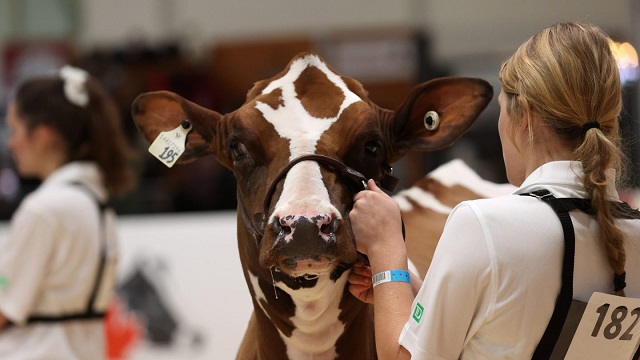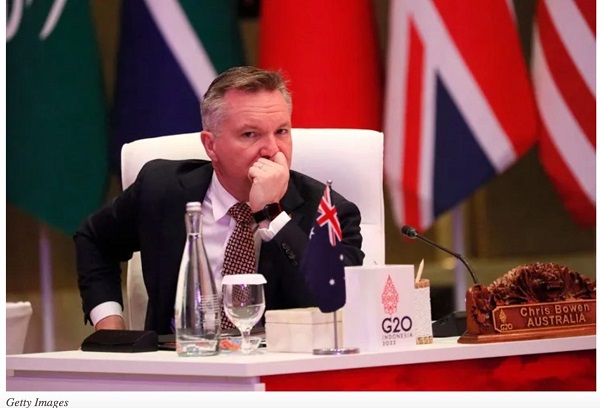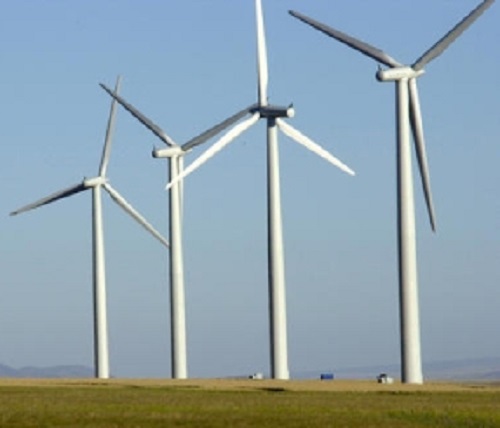Agriculture
Third Farm In Nanton, Alberta, Awarded Top Animal Welfare And Grassfed Certifications

NANTON, AB–Bar P Ranch, Ltd. is the third farming business in Nanton, Alberta, to be Certified Grassfed by A Greener World (AGW). This is the only certification and logo in the U.S. and Canada that guarantees food products come from animals fed a 100 percent grass and forage diet, raised outdoors on pasture or range for their entire lives, and managed according to the Certified Animal Welfare Approved by AGW leading welfare and environmental standards on an independent farm. While other grassfed labels exist, none has fully met consumer expectations when it comes to a grassfed and forage diet, environmental management, and farm animal welfare–until now.
Rob and Tami Palmer are both fourth-generation ranchers, raising grassfed Wagyu-Black Angus cattle on their ranch in Alberta. Their commitment to environmental stewardship and animal welfare is now verified by their new AGW certifications. The Palmers applied for the Certified Animal Welfare Approved by AGW and Certified Grassfed by AGW labels so they can sell grassfed beef cattle to their friends at nearby TK Ranch, one of Canada’s leading retailers of Certified Grassfed by AGW beef, although they will also continue selling high-quality, grassfed beef directly to customers under the Bar P Ranch brand.
According to recent research, demand for grassfed beef has increased by 25-30 percent every year over the last decade. But while demand for grassfed meat is sky-rocketing, not all grassfed labels are meeting consumer expectations–and some continue to permit highly questionable practices. Some meat currently marketed as grassfed could come from animals confined on dirt feedlots for long periods outside the growing season, or where growth hormones and subtherapeutic antibiotics are used–just as long as they were fed cut grass or forage.
AGW’s respected Certified Grassfed label is the only grassfed animal welfare label in North America. Unique among food labels, it guarantees:
- Ruminant animals raised outdoors on pasture for their entire lives, with a 100 percent grass and forage diet
- Animals raised according to the highest animal welfare and environmental standards in the U.S. and Canada
- High-welfare handling, transport, and slaughter of animals–including an annual review of slaughter facilities
Certified Grassfed by AGW is an optional, additional accreditation for farmers meeting Certified Animal Welfare Approved by AGW standards of production. Certified Animal Welfare Approved by AGW has been lauded by Consumer Reports as the only “highly meaningful” label for farm animal welfare, outdoor access and sustainability.
AGW Director of Communications and Outreach Emily Moose says:
“No other grassfed label can match the breadth, integrity, and transparency offered by AGW’s practical and achievable Certified Grassfed standards and certification procedures. We’re proud to support farmers and ranchers like Bar P Ranch, Ltd. and to help them promote their high-quality grassfed meat and sustainable farming practices to the public.”
Certified Animal Welfare Approved by AGW, Certified Grassfed by AGW beef from Bar P Ranch, Ltd. is available directly from the ranch, as well as under the TK Ranch label (see link above). For more information about Bar P Ranch, Ltd., visit barpranchbeef.com and find them on Facebook. Contact Tami Palmer at 403-646-5402 and [email protected].
For more information about Certified Grassfed by AGW visit https://agreenerworld.org/solutions-and-certificates/certified-grass-fed/.
ABOUT A GREENER WORLD
A Greener World (AGW) identifies, audits, certifies and promotes practical, sustainable farming systems by supporting farmers and ranchers and informing consumers. AGW’s growing family of trusted certifications includes Certified Animal Welfare Approved by AGW, Certified Grassfed by AGW and Certified Non-GMO by AGW. Each program is designed to have positive and measurable impacts on the environment, society and animals, and to encourage truly sustainable farming practices. AGW’s standards and procedures are robust and transparent and achievable.
A nonprofilt funded by public donations and membership, A Greener World offers a range of resources to help people make informed food choices, including an Online Directory of certified farms and products and Food Labels Exposed–a definitive guide to food label claims (available in print, online, and as a smartphone app). For more information visit agreenerworld.org.
For more stories visit Todayville.com
Agriculture
How oil and gas support food security in Canada and around the world

General view of the ‘TD Canadian 4-H Dairy Classic Showmanship’ within the 101st edition of Royal Agricultural Winter Fair at Exhibition Place in Toronto, Ontario, on November 6, 2023. The Royal is the largest combined indoor agriculture fair and international equestrian competition in the world. Getty Images photo
From the Canadian Energy Centre
‘Agriculture requires fuel, and it requires lubricants. It requires heat and electricity. Modern agriculture can’t be done without energy’
Agriculture and oil and gas are two of Canada’s biggest businesses – and they are closely linked, industry leaders say.
From nitrogen-based fertilizer to heating and equipment fuels, oil and gas are the backbone of Canada’s farms, providing food security for Canadians and exports to nearly 200 countries around the world.
“Canada is a country that is rich in natural resources, and we are among the best, I would even characterize as the best, in terms of the production of sustainable energy and food, not only for Canadians but for the rest of the world,” said Don Smith, chief operating officer of the United Farmers of Alberta Co-operative.
“The two are very closely linked together… Agriculture requires fuel, and it requires lubricants. It requires heat and electricity. Modern agriculture can’t be done without energy, and it is a significant portion of operating expenses on a farm.”
The need for stable food sources is critical to a global economy whose population is set to reach 9.7 billion people by 2050.
The main pillars of food security are availability and affordability, said Keith Currie, president of the Canadian Federation of Agriculture (CFA).
“In Canada, availability is not so much an issue. We are a very productive country when it comes to agriculture products and food products. But food affordability has become an issue for a number of people,” said Currie, who is also on the advisory council for the advocacy group Energy for a Secure Future.
The average price of food bought in stores increased by nearly 25 per cent over the last five years, according to Statistics Canada.
Restricting access to oil and gas, or policies like carbon taxes that increase the cost for farmers to use these fuels, risk increasing food costs even more for Canadians and making Canadian food exports less attractive to global customers, CFA says.
“Canada is an exporting nation when it comes to food. In order for us to be competitive we not only have to have the right trade deals in place, but we have to be competitive price wise too,” Currie said.

Under an incredible Saskatchewan sky, a farmer walks toward his air seeder to begin the process of planting this year’s crop. Getty Images photo
Canada is the fifth-largest exporter of agri-food and seafood in the world, exporting approximately $93 billion of products in 2022, according to Agriculture Canada.
Meanwhile, Canadians spent nearly $190 billion on food, beverage, tobacco and cannabis products in 2022, representing the third-largest household expenditure category after transportation and shelter.
Currie said there are opportunities for renewable energy to help supplement oil and gas in agriculture, particularly in biofuels.
“But we’re not at a point from a production standpoint or an overall infrastructure standpoint where it’s a go-to right away,” he said.
“We need the infrastructure and we need probably a lot of incentives before we can even think about moving away from the oil and gas sector as a supplier of energy right now.”
Worldwide demand for oil and gas in the agriculture sector continues to grow, according to CEC Research.
Driven by Africa and Latin America, global oil use in agriculture increased to 118 million tonnes of oil equivalent (Mtoe) in 2022, up from 110 million tonnes in 1990.
Demand for natural gas also increased — from 7.5 Mtoe in 1990 to 11 Mtoe in 2022.
Sylvain Charlebois, senior director, in the Agri-Food Analytics Lab at Dalhousie University, said food security depends on three pillars – access, safety, and affordability.
“Countries are food secure on different levels. Canada’s situation I think is envious to be honest. I think we’re doing very well compared to other countries, especially when it comes to safety and access,” said Charlebois.
“If you have a food insecure population, civil unrest is more likely, tensions, and political instability in different regions become more of a possibility.”
As a country, access to affordable energy is key as well, he said.
“The food industry highly depends on energy sources and of course food is energy. More and more we’re seeing a convergence of the two worlds – food and energy… It forces the food sector to play a much larger role in the energy agenda of a country like Canada.”
Agriculture
Australia ignoring the solution to government-induced malaise

Australian PM Chris Bowen
From the Frontier Centre for Public Policy
By Alan Moran
Conscious of the imperative of self-preservation, European governments and the EU Commission itself have already taken baby steps to dilute and delay carbon emission-abating and economy-crushing agricultural and energy policies.. Not so in Australia
Studying last month’s Davos meeting of the world’s (largely self-appointed) elites, Walter Russell Mead sees an inflection point.
He says that when they listened to Argentinian President Milei promoting free market capitalism, the Davosies’ applause was more than polite clapping. There was a sense that all was not well in the supposed government-planned China, and a recognition that the more hands-on EU governmental approach has resulted in Europe slipping behind the US with its lighter government touch over the economy. This was coupled with a concern that the farmer revolts around Europe reflected a sudden rejection of trust in the establishment. Above all, Ukraine has made the Euro grandees ‘uncomfortably aware of how dependent the global system is on the leadership that only a prosperous and self-confident America can provide’.
Conscious of the imperative of self-preservation, European governments and the EU Commission itself have already taken baby steps to dilute and delay carbon emission-abating and economy-crushing agricultural and energy policies.
Not so in Australia, where governments remain totally focused on reducing the economy’s productive potential.
The Albanese government, under the Svengali and serial ministerial failure of Chris Bowen, has turbocharged carbon abatement programs crippling energy. It has:
- Vastly increased direct and regulatory-enforced expansion of the transmission lines in an attempt to allow wind and solar to work.
- Introduced a requirement for the top 215 businesses to reduce their emission levels by 30 per cent over and above reductions made necessary by the subsidies generally.
- Put in place measures to combat objections to intrusive wind farms and transmission lines.
- Refused to introduce requirements for the rectification of land and safe disposal of the materials used in wind and solar facilities.
- Vastly expanded the budgetary assistance to wind, solar, and hydrogen.
- Introduced costly requirements on firms to identify the emissions of their own activities and of those of their suppliers and customers.
The measures have been put in place by politicians, hardly any of whom have any knowledge of the energy sector, how it works, and what its costs are. Politicians have been pressed in this direction by the so-called experts, a professional elite supported by and bankrolled by subsidy-seekers, who see the global warming con as a means by which they can get paid for promoting particular forms of energy.
But the outcome is already apparent in the loss of competitiveness of our industries. The bellwether is smelting and all three of the major aluminium smelters are now in hospital care, relying on government support to offset the imposts they incur from government penalties on cheap electricity. The distress is also seen in agricultural and mining industries, which in addition to being buffeted by ever-increasing environmental costs, with their prices set globally, are seeing their margins come under pressure.
Every week brings another measure – last week we saw requirements on car retailers to ensure more fuel-efficient – higher cost cars are sold with penalties on sellers that fail to meet these requirements, penalties that will certainly increase the price Australians pay for motor vehicles.
This week, Environment Minister Tanya Plibersek boasted of spending $205 million of taxpayers’ money to buy back another 44 gigalitres of water from Murray irrigators. This is part of a process to divert 2,700 gigalitres per annum (out of 7,000 gigalitres ‘high security’ water available) from productive agriculture to uses designated as ‘environmental’. These measures massively reduce the productivity of the Murray-Darling region, responsible for 35 per cent of the nation’s farm income. They were originally justified to respond to environmental agitators’ spurious claims that irrigation was creating salt infusions, claims that were reinforced during the ‘millennial’ drought of 1997-2008 by specious assertions that climate change would drastically reduce the available water. These original rationales having been disproven, politicians’ and activists’ hostility to productive enterprise have lent the programs an ongoing inertia.
We also saw a new $100 billion a year in additional carbon tax floated by Ross Garnaut and Rod Sims; their study’s funding source was not revealed but the beneficiaries would likely be, in my opinion, subsidy-seeking economy wreckers. While ostensibly rejecting that proposal, the Prime Minister has foreshadowed extensive new decarbonisation spending programs. Nothing is being learned from the collapse of Australia’s nickel mining industry, which cannot compete with overseas mines favoured by the low-cost coal-generated electricity that Australian governments are closing down.
In addition to the current $10 billion a year in subsidies through regulations forcing the use of wind and solar, and billions of dollars spent on revoking the productive use of irrigation water, governments provide huge sums to groups that promote such waste. Unlike squandering through inefficiency that is endemic in government programs, all this spending is aimed at poisoning once highly competitive low-cost industries. Adding to measures that load the dice against employers in workplace relations, it is akin to government forcing the nation to manufacture bombs to be dropped on the people financing them.
Has anybody put the solution more succinctly than Trump-aligned Presidential hopeful, Vivek Ramaswamy? His answer was, ‘Drill. Frack. Merit over “Diversity, Equity, and Inclusion”. Stop paying people to stay at home instead of work. Fire bureaucrats. Shut down corrupt agencies. End lobbying.’
Alan Moran is a noted economist who has analysed and written extensively from a free market perspective focusing on environmental issues, housing, network industries, and energy markets. First published here.
-

 COVID-192 days ago
COVID-192 days agoJapanese study shows disturbing increase in cancer related deaths during the Covid pandemic
-

 Education14 hours ago
Education14 hours agoSolar eclipse school closures underscore impact of learning loss
-

 Alberta15 hours ago
Alberta15 hours agoBuilding a 21st century transit system for Calgary
-

 Health9 hours ago
Health9 hours agoQuadriplegic man dies via euthanasia after developing bed sores waiting at Quebec hospital
-

 Health15 hours ago
Health15 hours agoSetback for the Transgender movement: Michael Shellenberger on leaked files revealing medical malpractice on children and vulnerable adults
-

 espionage9 hours ago
espionage9 hours agoConservative MP testifies that foreign agents could effectively elect Canada’s prime minister, premiers
-

 Health9 hours ago
Health9 hours agoTime for an intervention – an urgent call to end “gender-affirming” treatments for children
-

 Brownstone Institute1 day ago
Brownstone Institute1 day agoDeborah Birx Gets Her Close-Up








